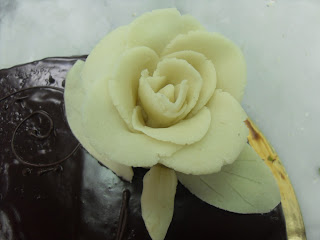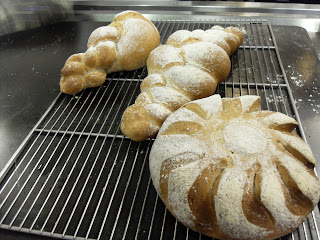On Thursday we were introduced to charlottes number 1 and 2, these consisted of a piped biscuit lining and base, constructed into a cake in a ring and filled with bavarian creams. As any good basic patisserie student will tell you, a bavarian cream is a custard set with gelatin and lightened with whipped cream. The end result is basically a dairy based mousse. In demo the bavarian creams used were chocolate and passion fruit. These were put together in appropriate sponge cases and decorated accordingly and, as expected, beautifully.
Bavarian chocolate charlotte
Passion fruit
Having been introduced, it was time to take things a step further and make a Charlotte. Here is a quick break down of class. Make a chocolate genoise sponge mix, do not over fold. Pipe mixture into firstly a long strip of fingers and secondly a spiral circle. Bake. Make a chocolate custard, add in gelatin and more chocolate whilst hot, leave to cool. Whip up some cream and fold into cooled, setting, custard. Take cooked sponge and line firstly the sides and secondly the base of a cake ring. Fill with mousse and level. Chill in fridge. Make chocolate decorations and put it all together. The only slight problem I had in class was I forgot to weigh down my baking sheet in the oven resulting in it folding in on itself and half of my sponge being unusable. Fortuately there was enough sponge about to salvage the situation. Making the chocolate decorations was the definate highlight. Good, messy, fun and I was pleased with the resulting flower.
Moving on to the third Charlotte. This was still a cold cake, but filled this time with a mousse. The key difference from the baravian cream is that the base of a mousse isnt dairy based. This week I have discovered I really love mousse. Its not something I would of usually considered much in life before, but I have definately been missing out. The mousse of the moment was a vibrant blackcurrant, topped off with a shiny blackcurrant glaze and here are the examples from demo.
Practical for this cake was really enjoyable. The cake ring near enough ensures a neat finish, there was plenty of time so no rushing about, the blackcurrant meant that everything was super bright and we were in a warm kitchen away from the cold. If I was to be asked again, I'd have a date with Charlotte every saturday afternoon! The main tricky bit was the lining. To get that striped effect you have to construct a kind of jam- sponge tower, slice it up and squeeze it tight round the edge of the ring. The glaze also requires a bit of accuracy with temperature, and of course there was the dreaded piping but I think that is gradually starting to improve.
On tasting the blackcurrant Charlotte gets my vote. Which lovely lady does it for you?


























































